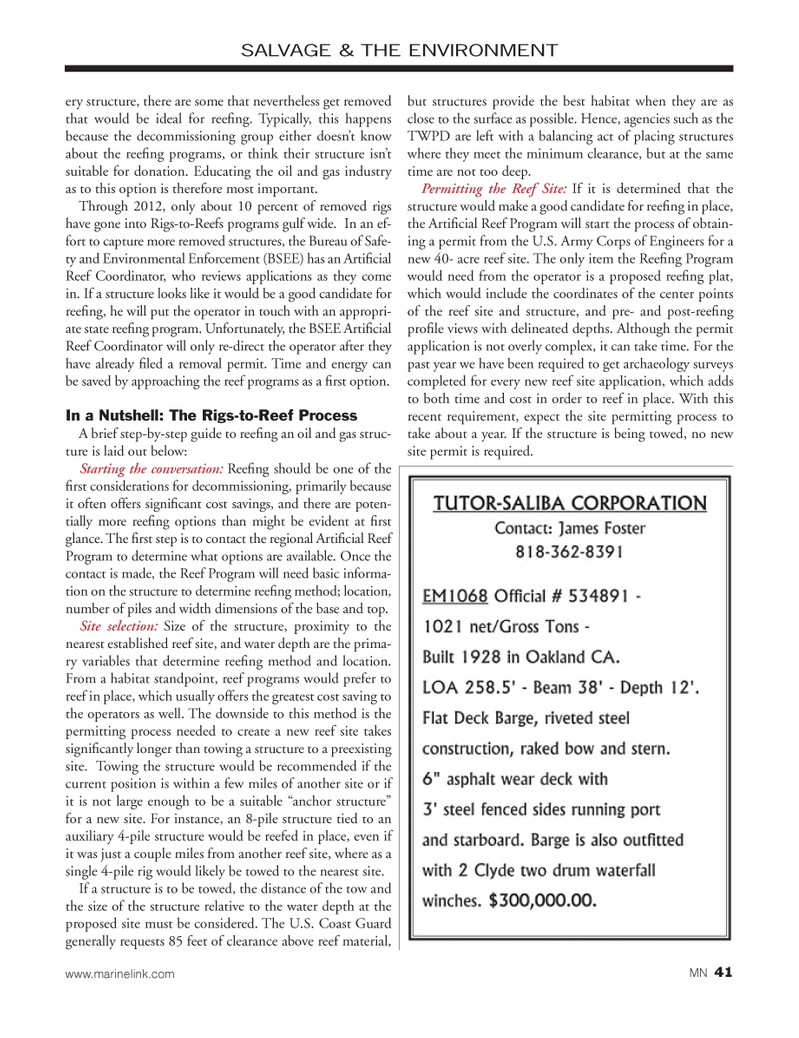
Page 41: of Marine News Magazine (January 2014)
Tug Boat Technology
Read this page in Pdf, Flash or Html5 edition of January 2014 Marine News Magazine
SALVAGE & THE ENVIRONMENT ery structure, there are some that nevertheless get removed that would be ideal for reefi ng. Typically, this happens because the decommissioning group either doesn’t know about the reefi ng programs, or think their structure isn’t suitable for donation. Educating the oil and gas industry as to this option is therefore most important.
Through 2012, only about 10 percent of removed rigs have gone into Rigs-to-Reefs programs gulf wide. In an ef- fort to capture more removed structures, the Bureau of Safe- ty and Environmental Enforcement (BSEE) has an Artifi cial
Reef Coordinator, who reviews applications as they come in. If a structure looks like it would be a good candidate for reefi ng, he will put the operator in touch with an appropri- ate state reefi ng program. Unfortunately, the BSEE Artifi cial
Reef Coordinator will only re-direct the operator after they have already fi led a removal permit. Time and energy can be saved by approaching the reef programs as a fi rst option.
In a Nutshell: The Rigs-to-Reef Process
A brief step-by-step guide to reefi ng an oil and gas struc- ture is laid out below:
Starting the conversation: Reefi ng should be one of the fi rst considerations for decommissioning, primarily because it often offers signifi cant cost savings, and there are poten- tially more reefi ng options than might be evident at fi rst glance. The fi rst step is to contact the regional Artifi cial Reef
Program to determine what options are available. Once the contact is made, the Reef Program will need basic informa- tion on the structure to determine reefi ng method; location, number of piles and width dimensions of the base and top.
Site selection: Size of the structure, proximity to the nearest established reef site, and water depth are the prima- ry variables that determine reefi ng method and location.
From a habitat standpoint, reef programs would prefer to reef in place, which usually offers the greatest cost saving to the operators as well. The downside to this method is the permitting process needed to create a new reef site takes signifi cantly longer than towing a structure to a preexisting site. Towing the structure would be recommended if the current position is within a few miles of another site or if it is not large enough to be a suitable “anchor structure” for a new site. For instance, an 8-pile structure tied to an auxiliary 4-pile structure would be reefed in place, even if it was just a couple miles from another reef site, where as a single 4-pile rig would likely be towed to the nearest site.
If a structure is to be towed, the distance of the tow and the size of the structure relative to the water depth at the proposed site must be considered. The U.S. Coast Guard generally requests 85 feet of clearance above reef material, but structures provide the best habitat when they are as close to the surface as possible. Hence, agencies such as the
TWPD are left with a balancing act of placing structures where they meet the minimum clearance, but at the same time are not too deep.
Permitting the Reef Site: If it is determined that the structure would make a good candidate for reefi ng in place, the Artifi cial Reef Program will start the process of obtain- ing a permit from the U.S. Army Corps of Engineers for a new 40- acre reef site. The only item the Reefi ng Program would need from the operator is a proposed reefi ng plat, which would include the coordinates of the center points of the reef site and structure, and pre- and post-reefi ng profi le views with delineated depths. Although the permit application is not overly complex, it can take time. For the past year we have been required to get archaeology surveys completed for every new reef site application, which adds to both time and cost in order to reef in place. With this recent requirement, expect the site permitting process to take about a year. If the structure is being towed, no new site permit is required. www.marinelink.com MN 41
MN JAN14 Layout 32-49.indd 41 12/20/2013 2:04:04 PM

 40
40

 42
42
